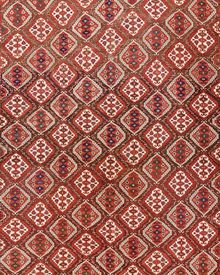Kyrgyz Carpet
Kyrgyz carpet or Kyrgyz Rug is one of the eastern rugs that woven in Kyrgyzstan.
A Turkic ethnic group of Eastern Turkestan and Kirghizstan. They make felt pieces of complex design through felt inlay, appliqué‚ and embroidery. They weave ornamental warp-faced bands which they sew into gadzhari. They also make reed screens for yurt interiors of geometric designs by wrapping reeds with colored threads. Small rugs, pouches, and animal trappings are woven with knotted pile.[1]
| Kyrgyz Carpet | |
|---|---|
 | |
| General information | |
| Name | Kyrgyz Carpet |
| Original name | فرش قرقیزستان، قالی قرقیزستان |
| Alternative name(s) | Kyrgyz Rug |
| Origin | |
| Technical information | |
| Common designs | Boteh, Geometric |
| Common colors | Red, Blue, Brown, Ivory |
| Pile material | Wool |
| Foundation material | Wool |
| Knot type | Asymmetrical (Persian) |
History
Kyrgyz (Kirghiz) The Kyrgyz, also spelled Kirgiz in the antique trade, are a tribe living in the independent republic of Kyrgyzstan in Central Asia. The Kyrgyz people are a large Turkic ethnic group, some of whom continue to live as seminomads, working in agriculture, raising livestock, and herding sheep. Kyrgyzstan was once part of the historical eastern Turkestan region. The ancient city of Osh in Kyrgyzstan was once a trade center on the Silk Road. Kyrgyz rugs are known in the antique market from the mid-nineteenth century.
Kyrgyz rugs are woven in a geometric, nomadic style greatly influenced by the Turkmen, Kazakh, and Uzbek tribes of greater Turkestan. Boteh (paisley), Gul (flower), Hook, Lattice, Star, flower head, palmette, and other tribal motifs appear in both flatwoven and pile rugs. Borders are generally narrow, with one or two minor guard stripes. Diagonal or horizontal bands, S motifs, flowers with vines, and other tribal ornaments are made as border designs. At times, one minor border frames the background of the rug.
Kyrgyz weavers primarily make flatwoven rugs and Felt Carpets. The pile weavings usually have a wool foundation and a wool pile, but cotton can be chosen for the weft. The Persian (asymmetric) knot is universally used.
The rugs are bold in coloration, with mainly reds, blues, browns, or ivory employed in the background. In addition, different shades of saffron, and green are employed for the design elements and borders.
The Kyrgyz also make a variety of day-to-day tribal items in pile and flatweave, including many types of nomadic bags, tent hangings, animal trap-pings, and tribal decorations. Kyrgyz formats range from small bag face rugs to carpets approximately twelve feet by five feet, and the grade qualities are medium to good.[2]
References
Bibliography
- Abraham Levi Moheban. 2015. The Encyclopedia of Antique Carpets: Twenty-Five Centuries of Weaving. NewYork: Princeton Architectural Press.
- Peter F. Stone. 2013. Oriental Rugs: An Illustrated Lexicon of Motifs, Materials, and Origins. North Clarendon: Tuttle.